#butter market industry
Explore tagged Tumblr posts
Text
Butter Market Analysis, Size & Growth to 2028

Explore a comprehensive Butter Market analysis encompassing the latest trends and insights, providing a clear perspective on the Butter Market's size and growth prospects.
#Butter market product#butter market insight#butter market share#butter market size#butter industry analysis#major players of butter industry#amul butter market of india#butter market industry#key players in the butter market
0 notes
Text
🌍 Global Cocoa Butter Equivalent (CBE) Market Report 🍫
The Cocoa Butter Equivalent (CBE) Market research report provides a deep dive into the market dynamics, competitive landscape, and regional growth trends. It's designed to give businesses the strategic insights needed to identify growth opportunities, manage risks, and craft effective competitive strategies in a rapidly changing market.
📊 Market Overview & Projections 📈
According to Straits Research, the global Cocoa Butter Equivalent (CBE) Market was valued at USD 1189.43 million in 2023. It is projected to grow from USD 1,262.22 million in 2024 to USD 2,030.04 million by 2032, expanding at a CAGR of 6.12% over the forecast period (2024–2032).
Stay ahead of the curve by exploring the latest trends and projections in this growing sector. 👉 Request a Sample Report Today
🔍 Global Cocoa Butter Equivalent (CBE) Market Segmentation 🧩
The CBE market is divided into various segments, each contributing to its dynamic growth:
🌱 By Type
Palm Oil
Shea Butter
Sal Fat
Others
🍽️ By Application
Food & Beverages
Pharmaceuticals
Others
To explore detailed segmentation, visit: 👉 In-depth Segmentation Analysis
💡 Why Invest in this Report? 📊
Leverage Data for Strategic Decision-Making: Unlock valuable market data to make informed business decisions and identify new opportunities for growth and innovation.
Craft Expansion Strategies for Diverse Markets: Build expansion strategies tailored to specific market segments, ensuring your business thrives in diverse environments.
Conduct Comprehensive Competitor Analysis: Gain insights into your competitors' strategies, positioning, and operational strengths and weaknesses.
Gain Insight into Competitors' Financial Metrics: Understand competitors' financial performance, including sales, revenue, and profitability metrics.
Benchmark Against Key Competitors: Compare your performance with leading players to identify areas for improvement and uncover potential competitive advantages.
Formulate Region-Specific Growth Strategies: Develop region-specific strategies to take advantage of local market conditions and consumer preferences.
🏢 Top Leading Players in the CBE Market 🌟
AAK AB
Bunge
Fuji Vegetable Oil, Inc.
Intercontinental Specialty Fats Sdn. Bhd. (ISF)
Makendi Worldwide
Manorma Industries Limited
Musim Mas
Olam International Limited
WILMAR CAHAYA INDONESIA TBK
USHA Edible Oils
Wild Oils
Wilmar International Ltd.
Others
📝 Reasons to Purchase This Report 📚
Access Comprehensive Information: Save time and effort by gaining access to a treasure trove of research, data, and analysis that would be difficult to gather independently.
Enhanced Decision-Making: Make well-informed strategic decisions with valuable insights into market trends, consumer behavior, and industry factors.
Achieve Competitive Advantage: Stay ahead of the competition by understanding market dynamics, competitor strategies, and trends.
Credibility and Reliability: Trust in the rigorous research and analysis that underpin this report, ensuring accurate and actionable insights.
Cost-Effective Research: Access a wealth of market intelligence without the need for extensive resources, saving you time and money.
🌍 Regional Analysis of the CBE Market 🌎
The regional analysis section of the report provides a detailed evaluation of the Cocoa Butter Equivalent (CBE) Market in key regions, including:
North America (U.S., Canada, Mexico)
Europe (Germany, France, UK, Italy, Russia)
Asia-Pacific (China, Japan, India, Korea, Southeast Asia)
South America (Brazil, Argentina)
Middle East & Africa (Saudi Arabia, UAE, Egypt)
This section also includes precise volume and market size analysis for each region, assessing both past and future growth trends.
🌐 To Understand How COVID-19 Impact Is Covered in This Report, Click Here 👉 COVID-19 Impact Analysis
🖋️ About Straits Research Straits Research is committed to delivering top-notch market research services. Our team of experienced researchers and analysts provide insightful, actionable data that helps businesses make informed decisions. We offer a customized approach to cater to each client's specific needs, ensuring they get the most relevant and valuable insights.
📞 Contact Us
Email: [email protected]
Address: 825 3rd Avenue, New York, NY, USA, 10022
Phone: UK: +44 203 695 0070 | USA: +1 646 905 0080
#Cocoa Butter Equivalent (CBE) Market Market#Cocoa Butter Equivalent (CBE) Market Market Share#Cocoa Butter Equivalent (CBE) Market Market Size#Cocoa Butter Equivalent (CBE) Market Market Research#Cocoa Butter Equivalent (CBE) Market Industry#What is Cocoa Butter Equivalent (CBE) Market?
0 notes
Text
Illipe Butter in Food Industry Market : Advanced Technologies & Growth Opportunities Worldwide By 2030

Illipe butter is a type of vegetable butter derived from the nuts of the Shorea stenoptera tree, which is native to Southeast Asia. It is commonly used in the food industry for its unique properties and benefits. Here’s an overview of Illipe butter in the food industry market:
Composition and Properties: Illipe butter has a high melting point, which makes it suitable for applications where heat stability is required, such as baking and confectionery. It is also rich in fatty acids, particularly stearic and oleic acids, which contribute to its solid consistency at room temperature.
Chocolate and Confectionery: Illipe butter is often used as a substitute for cocoa butter in chocolate and confectionery products. It provides similar texture and mouthfeel while offering a lower cost alternative. It can be used in chocolate bars, truffles, coatings, and fillings.
Bakery Products: Illipe butter is used in the production of various bakery products, including cookies, pastries, and bread. Its high melting point helps improve the stability and texture of baked goods, allowing them to maintain their shape and structure during baking.
Margarine and Spreads: Illipe butter can be used as an ingredient in margarine and spreads. Its solid consistency at room temperature provides structure and stability to these products, while its fatty acid composition contributes to the desired texture and flavor.
Skin Care Products: Apart from its applications in the food industry, Illipe butter is also used in the cosmetic and skincare industry. It is valued for its moisturizing and emollient properties, making it suitable for creams, lotions, lip balms, and soaps.
Market Demand and Trends: The demand for Illipe butter has been growing in recent years due to increasing consumer interest in natural and plant-based ingredients. It offers an alternative to animal-derived fats, such as butter or lard, and appeals to customers seeking vegan or vegetarian options. The market for Illipe butter is influenced by factors such as the growing preference for clean label ingredients, sustainable sourcing practices, and the rise in artisanal and premium food products.
Sustainability and Sourcing: The sustainability of Illipe butter production is an important consideration in the food industry. Responsible sourcing practices, including supporting fair trade initiatives and promoting sustainable agriculture, are increasingly important for both consumers and businesses. Ensuring that Illipe butter is harvested and processed in an environmentally friendly and socially responsible manner can be a key factor in its market acceptance.
0 notes
Link
0 notes
Text

Enterprise, Alabama built a monument to the Boll Weevil in 1919. In 1915, the weevil destroyed a majority of the town's coffee and cotton crop. On the advice of Alabama's famous black agronomist George Washington Carver, the town switched instead to growing peanuts, which circus owner PT Barnum started to roast to use as concession stand food in his circus, leading to widespread popularity for them as a snack (along with the previously unknown drink, pink lemonade).

The Alabama town made so much more money with peanuts as a cash crop, and so they built a monument to the boll weevil for pushing them to switch away from coffee and cotton. It is the only statue dedicated to an insect.
Contrary to popular belief, George Washington Carver did not invent peanut butter, but a black Canadian, Marcellus Gilmore Edsen, did (he called it peanut paste). It was not popular until John Kellogg (yes, the cereal guy) was able to create a process to make it in batches industrially, and mass market it as a diet food for people who needed protein but couldn't chew.
3K notes
·
View notes
Text
Volkswagen Group CEO Oliver Blume was booed by a crowd of 20,000 employees after stating that the company is not “operating in a fantasy world.” The company already saw 100,000 union members walkout on Monday. “As management we’re not operating in a fantasy world. We are making decisions in a rapidly changing environment,” Blume stated. But the fantasy of climate change is indeed what the company is operating under.
Blume said that Volkswagen must begin to offload vehicles to Chinese consumers. Why would Chinese consumers by a European EV when they can purchase a Chinese model for a fraction of the cost? I recently discussed how even American auto CEOs were praising the technological advances of Chinese EVs. China was once a large market for Germany’s auto exports but that has changed since the government applied countless regulations in the name of climate change.
Then Volkswagen had its emissions scandal where it falsified emissions testing to sell to US consumers. I wrote in 2015: “This event appears to highlight the turning point of 2015.75; in hindsight, we will probably look back at this turning point as the start of a serious economic decline that will strike Europe’s biggest economy. The German car industry is the largest and what is unraveling is a taint upon all German cars, which is unfair. This involved diesel only. Nonetheless, things are never always fair.”
Now the company is looking to cut pay for 120,000 workers. Operating profits have fallen by 11.4% and they simply cannot continue producing these EVs at the same pace they were producing dreaded fuel-powered cars because the demand is not there. The government is actively preventing the auto industry from flourishing. It is a fantasy to believe that the German auto industry can continue adhering to the country’s climate change objectives that believe it can reduce carbon emissions by 65% within the next 5 years.
Yet another reason why the entire European Union is facing a recession. Germany is the bread and butter of the EU – the economic powerhouse. You had 17% of all GDP in Germany derived from the auto industry in 2023, and now the nation’s top auto manufacturer is struggling to make a profit.
28 notes
·
View notes
Text
You're always holding on to stars (Moon Knight system x Famous!F!reader)

Prompt: Stargazing.
Words: 736
They lay out in the field, her head on his chest as they gaze out on the stars in the sky. Marc and His childhood friend, his high School sweetheart, the one who will get away, He knows her asperations are what will separate them. She had just gotten signed to a big record company and was moving to New York. And he wasn’t coming. They had decided it was best to take a break, give her the room to grow in her industry, unattached. Neither of them really wanted to. They we’re both very in love, but Marc Knew she would do amazing things, with or without him.
“I used to think this all was ours” Marc mutters as they looks out on the stars. “You and me against the world. Forever.”
“Me too. I never thought I’d actually get signed. I figured it would be the two of us, open mic nights at the coffee house, normal lives…” She softly says as she cuddles in closer to him. He wraps an arm around her and squeezes her tight
“Don’t feel bad for following your dreams. I’ll always be there to support you.”
“I know, I just…I wish you were coming with me. I’m going to miss you.” She sighs.
“Cheer up butter cup. Its not forever, just until you get your feet on the ground right?” He takes her chin in his hand and looks into her eyes.
“Right…just a break…Not a break up.”
~
Two years have passed, they have stayed in pretty close contact, and when Marc and Steven started to live a more integrated life she had taken the time to come out to London to get to know him. She stayed with him for a visit. And Steven was absolutely enchanted with her. She was an amazing artist he was enamored from the moment they met. As they walked through Camden Market they were stopped a few times by excited fans. Steven watched and helped take pictures with a smile on his face.
“I’m sorry Steven I know you wanted to just have some time the two of us…” She smiles sheepishly at him.
“No! I’m not bothered at all! It’s nice how sweet you are to your fans! It’s quite…adorable” He chuckles and rubs the back of his neck as he looks at her. He was falling for her hard…he could understand what had Marc hooked to her.
As they days in London pass, She, Marc and Steven start to fall into a pattern, and tabloids start talking…And much too soon she has to leave again. As Steven gets to say his goodbye he holds her in his arms.
“How is it that you're right here…why do I miss you so much?” Steven asks with tears in the corners of his eyes.
“Hey now don’t cry, we decided, I’ll be back, we’re going to make this work this time. I promise.” She reassures him while wiping the tears from his eyes. She smiles at him.
“I feel Like I’m Stargazing. Watchin’ your life from afar. You’re my star…Shining brighter than the rest.” Steven says sweetly as he presses his forehead against hers. She smiles then leans in to kiss him.
~
As the years pass eventually the fame and hype dies down, and Marc, Steven and her are able to live mostly normal lives, eventually, they also integrate their third alter Jake into their happy family. Jake take a little more time to warm up to her, but as the years pass, wedding anniversaries come and go, Jake is as much in love with her as the others. It was a beautiful evening as they sat on the balcony of their home looking out on the sky as the stars start to show.
“Estrella ... te ves tan hermosa en el crepúsculo…” Jake says to her with his voice low and pressing his body against hers as she leans on the railing. She chuckles and looks over her shoulder at him.
“You’re too cheesy.” She teases.
“What? Sólo digo la verdad, cariño. You know this.” He says in a mock offended tone as he pulls her closer, turning her to face him. “I close my eyes and think about tomorrow and All I see is us…stargazing…” He looks into her eyes, gazing into them he smiles. The stars in the sky will never compare to those in her eyes.

Translations:
Estrella ... te ves tan hermosa en el crepúsculo : Star...you look so beautiful in the twilight
Sólo digo la verdad, cariño.: I only speak the truth my darling.
Bingo Masterlist
Tag: @moonknight-events @juneknight @spacecowboyhotch
#moon knight#marc spector#x reader#jake lockley#steven grant#marc spector x reader#steven grant x reader#jake lockely x reader#moonknightevents#moon boys#moon knight x reader#Spotify#drabble
93 notes
·
View notes
Text
Milton Orr looked across the rolling hills in northeast Tennessee. “I remember when we had over 1,000 dairy farms in this county. Now we have less than 40,” Orr, an agriculture adviser for Greene County, Tennessee, told me with a tinge of sadness.
That was six years ago. Today, only 14 dairy farms remain in Greene County, and there are only 125 dairy farms in all of Tennessee. Across the country, the dairy industry is seeing the same trend: In 1970, more than 648,000 US dairy farms milked cattle. By 2022, only 24,470 dairy farms were in operation.
While the number of dairy farms has fallen, the average herd size—the number of cows per farm—has been rising. Today, more than 60 percent of all milk production occurs on farms with more than 2,500 cows.

This massive consolidation in dairy farming has an impact on rural communities. It also makes it more difficult for consumers to know where their food comes from and how it’s produced.
As a dairy specialist at the University of Tennessee, I’m constantly asked: Why are dairies going out of business? Well, like our friends’ Facebook relationship status, it’s complicated.
The Problem with Pricing
The biggest complication is how dairy farmers are paid for the products they produce.
In 1937, the Federal Milk Marketing Orders, or FMMO, were established under the Agricultural Marketing Agreement Act. The purpose of these orders was to set a monthly, uniform minimum price for milk based on its end use and to ensure that farmers were paid accurately and in a timely manner.
Farmers were paid based on how the milk they harvested was used, and that’s still how it works today.
Does it become bottled milk? That’s Class 1 price. Yogurt? Class 2 price. Cheddar cheese? Class 3 price. Butter or powdered dry milk? Class 4. Traditionally, Class 1 receives the highest price.
There are 11 FMMOs that divide up the country. The Florida, Southeast, and Appalachian FMMOs focus heavily on Class 1, or bottled, milk. The other FMMOs, such as Upper Midwest and Pacific Northwest, have more manufactured products such as cheese and butter.
For the past several decades, farmers have generally received the minimum price. Improvements in milk quality, milk production, transportation, refrigeration, and processing all led to greater quantities of milk, greater shelf life, and greater access to products across the US. Growing supply reduced competition among processing plants and reduced overall prices.
Along with these improvements in production came increased costs of production, such as cattle feed, farm labor, veterinary care, fuel, and equipment costs.
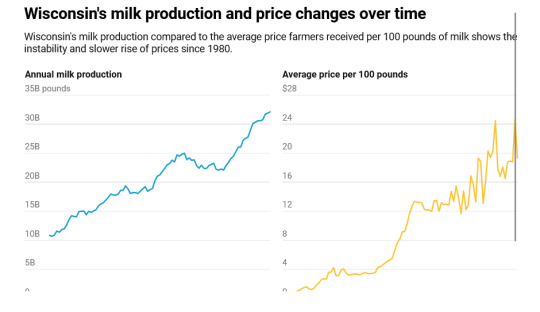
Researchers at the University of Tennessee in 2022 compared the price received for milk across regions against the primary costs of production: feed and labor. The results show why farms are struggling.
From 2005 to 2020, milk sales income per 100 pounds of milk produced ranged from $11.54 to $29.80, with an average price of $18.57. For that same period, the total costs to produce 100 pounds of milk ranged from $11.27 to $43.88, with an average cost of $25.80.
On average, that meant a single cow that produced 24,000 pounds of milk brought in about $4,457. Yet, it cost $6,192 to produce that milk, meaning a loss for the dairy farmer.
More efficient farms are able to reduce their costs of production by improving cow health, reproductive performance, and feed-to-milk conversion ratios. Larger farms or groups of farmers—cooperatives such as Dairy Farmers of America—may also be able to take advantage of forward contracting on grain and future milk prices. Investments in precision technologies such as robotic milking systems, rotary parlors, and wearable health and reproductive technologies can help reduce labor costs across farms.
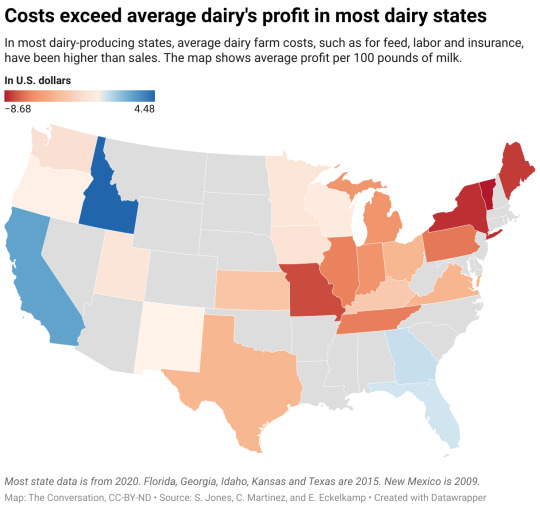
Regardless of size, surviving in the dairy industry takes passion, dedication, and careful business management.
Some regions have had greater losses than others, which largely ties back to how farmers are paid, meaning the classes of milk, and the rising costs of production in their area. There are some insurance and hedging programs that can help farmers offset high costs of production or unexpected drops in price. If farmers take advantage of them, data shows they can functions as a safety net, but they don’t fix the underlying problem of costs exceeding income.
Passing the Torch to Future Farmers
Why do some dairy farmers still persist, despite low milk prices and high costs of production?
For many farmers, the answer is because it is a family business and a part of their heritage. Ninety-seven percent of US dairy farms are family owned and operated.
Some have grown large to survive. For many others, transitioning to the next generation is a major hurdle.
The average age of all farmers in the 2022 Census of Agriculture was 58.1. Only 9 percent were considered “young farmers,” age 34 or younger. These trends are also reflected in the dairy world. Yet, only 53 percent of all producers said they were actively engaged in estate or succession planning, meaning they had at least identified a successor.
How to Help Family Dairy Farms Thrive
In theory, buying more dairy would drive up the market value of those products and influence the price producers receive for their milk. Society has actually done that. Dairy consumption has never been higher. But the way people consume dairy has changed.
Americans eat a lot, and I mean a lot, of cheese. We also consume a good amount of ice cream, yogurt, and butter, but not as much milk as we used to.
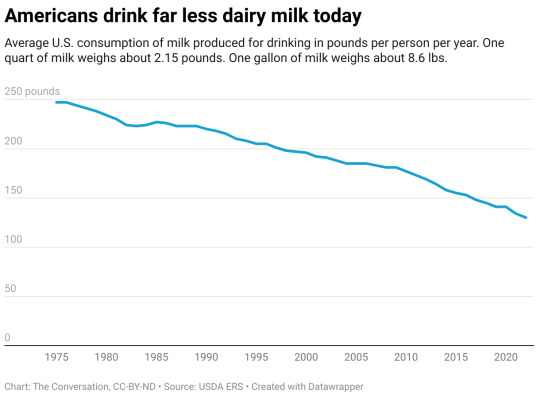
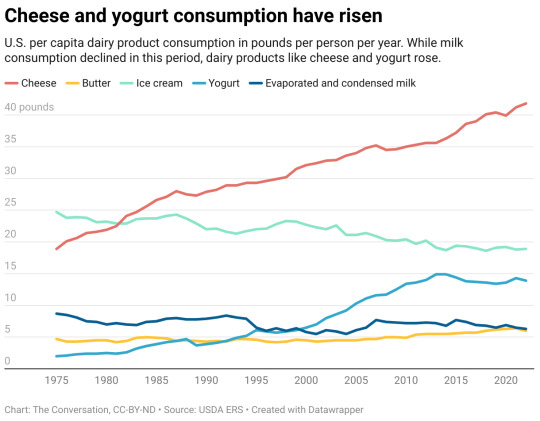
Does this mean the US should change the way milk is priced? Maybe.
The FMMO is currently undergoing reform, which may help stem the tide of dairy farmers exiting. The reform focuses on being more reflective of modern cows’ ability to produce greater fat and protein amounts; updating the cost support processors receive for cheese, butter, nonfat dry milk, and dried whey; and updating the way Class 1 is valued, among other changes. In theory, these changes would put milk pricing in line with the cost of production across the country.
The US Department of Agriculture is also providing support for four Dairy Business Innovation Initiatives to help dairy farmers find ways to keep their operations going for future generations through grants, research support, and technical assistance.
Another way to boost local dairies is to buy directly from a farmer. Value-added or farmstead dairy operations that make and sell milk and products such as cheese straight to customers have been growing. These operations come with financial risks for the farmer, however. Being responsible for milking, processing, and marketing your milk takes the already big job of milk production and adds two more jobs on top of it. And customers have to be financially able to pay a higher price for the product and be willing to travel to get it.
33 notes
·
View notes
Text
It's my birthday today, and the local grocery store was thoughtful enough to stock the Dragon Ball Z Reese's Puffs, so I'm gonna try it out. Join me, won't you?
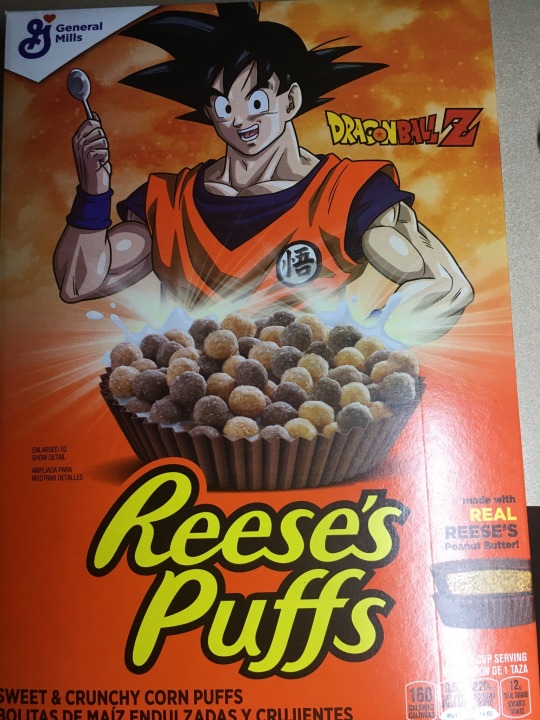
I still can't believe this is real. I mean, Reese's Puffa is kind of surreal enough as it is. It sounds like some satirical brand meant to poke fun at sugary kids' cereals. The box says "Made with REAL REESE'S Peanut Butter", the same way a fruit-flavored beverage will claim to contain genuine fruit.
The bowl on the box art is a Reese's cup, so it basically depicts candy being served in more candy. I'm old enough to remember when they would photograph cereal as "part of a complete breakfast", and there'd be grapefruits and toast and maybe a hard boiled egg. Basically they were admitting that the cereal was so unhealthy that you needed to eat three or four other breakfasts to make up for it. I just liked the photos because they were so picturesque. Ah, to have unlimited free time to prepare a leisurely 4-course breakfast while reading the paper. I just assumed everyone else was having toast with their cereal except my family, but yeah, it never really made any sense.
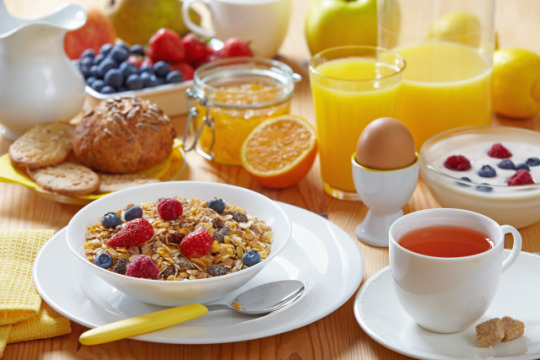
I haven't even gotten to Goku yet, but first I want to talk about his spoon. I don't think we see him holding a spoon very often. He's usually a chopsticks kind of guy, or he'll just use his bare hands or even dunk his head into the bowl. It kind of looks like a ladle when he holds it like that, which implies he cooked this bowl of candy soup all by himself, and he's showing it off like a proud chef. This spoon kicks ass, is what I'm trying to say.
But the real reason I bought this is because of that orange hillbilly who needs no introduction. I wasn't even looking for Reese's Puffs. It was the furthest thing from my mind. No, I was stocking up on the old-man cereal I require to survive, when I just saw him staring at me, with his friendly-yet-confident smile. Goku's not pressuring you to buy the cereal. He's sure you'll enjoy it, but it's okay if you want to take a pass. He'll just enjoy all this peanut butter chocolate goodness all by himself. Goku is truly the ideal spokesman. How can you say no to this lovable hunk?
I'm kind of out of touch when it comes to cereal marketing, but I'm pretty sure this sort of cross-promotion is a rarity. Like, they once put WWE wrestlers on Wheaties or something, but usually if the cereal companies want a cartoon on the box they'll just make their own character. Or if the cartoon people want to put their guy in the cereal aisle, they'll just commission a whole new cereal just for that brand. C-3PO had his own cereal for a while. It was pretty good!
What I'm saying is that it's kind of unusual to see a popular character like this on a cereal box. The only exception I can come up with is Fred Flintstone on Fruity and Cocoa Pebbles, but I always assumed that those were specifically "Flintstones Cereal".
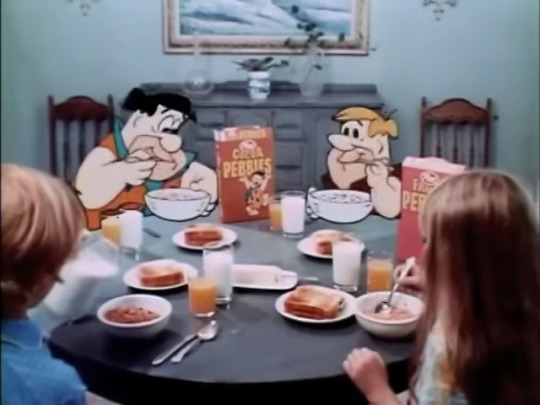
Other than that, yeah, I can't think of any other examples of cartoon characters appearing on unaffiliated cereal boxes like this. Well, I drew my DBZ OC on a box of All-Bran today, but I don't think that counts.
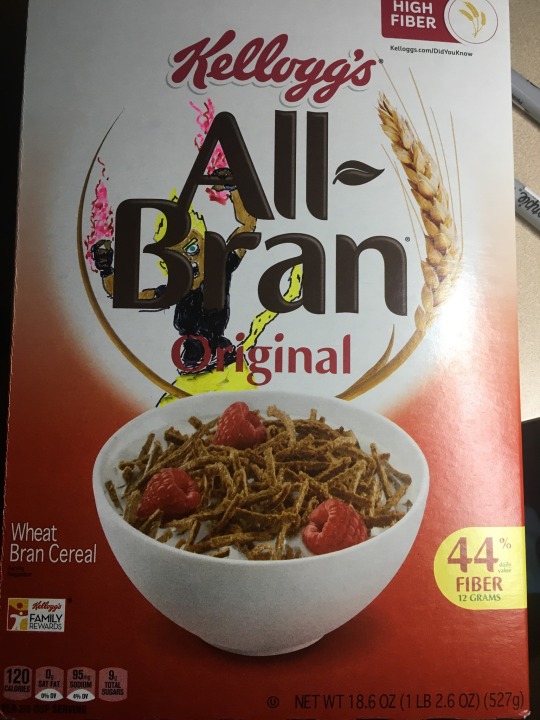
"MY FIBER IS MAXIMUM, KAKAROT!"

I wondered what was up with the picture of Piccolo on the back of the box, and it turns out that he's one of seven different characters you can find on the back of the box. Collect them all! Aw man, that Cell one looks fucking sick! I don't know how they distributed these. Maybe they roll them out in waves and Piccolo's came first. Or maybe it's random and I might have found a Cell if I'd checked more boxes at the store. Well, Piccolo's pretty good. I guess.
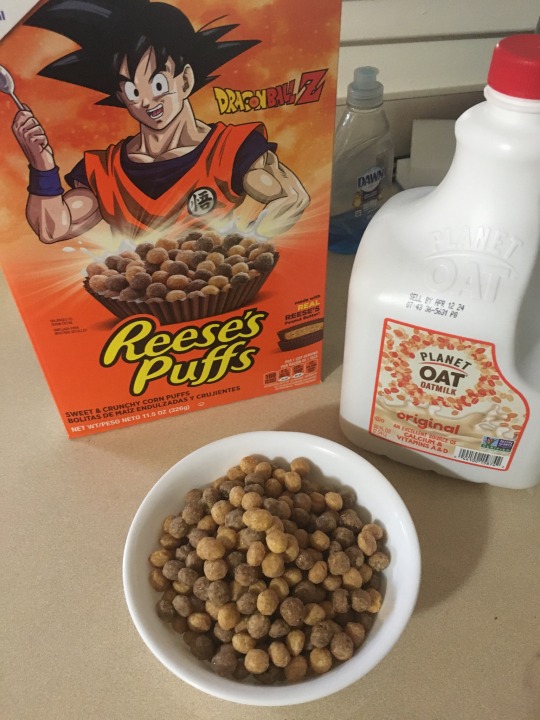
All right, I just poured myself a bowl and Goku's cereal is gonna have to set course for Planet Oat. The dairy industry may not applaud my shopping choices, but I like oat milk because it doesn't spoil as quickly as cow milk, and it's got a nice oat-y flavor that compliments the cardboard taste of All-Bran.
I did not put Dawn liquid soap in my cereal. This time.
So what's the verdict here? Well, the first few bites were pretty tasty, and then I realized I was getting kind of sick of this as I made my way to the bottom of the bowl. The peanut butter flavor overwhelms everything. It has a very strong odor, so if you like Reese's peanut butter cups you can just sit this out in your room and savor the aroma. I barely registered any chocolate flavor at all. I mean, I believe they put it there, but the peanut butter is the whole story to this.
It's basically Chocolate Frosted Sugar Bombs from Calvin and Hobbes, only this is a special Peanut Butter variant they made. I never really appreciated the jokes about sugary cereals before. I grew up on Frosted Flakes and the like, but there were a certain class of cereals that my mom would just refuse to buy. My grandparents would have them, but I never really understood the difference between Frosted Flakes and Honey Smacks. As I got older, I ate less cereal in general, but that was mostly because I fell out of the habit of eating breakfast altogether.
But now I'm 47, and the only cereal I eat these days is bran topped with diced peaches and a couple of packets of artificial sweetener, so Reese's Puffs is way, way too sugary for my palate. It's not bad, but a little goes a long way for me.
When I was a kid, old people were always griping about all the stuff they couldn't eat anymore. I remember Isaac Asimov writing mournfully about how he couldn't have an Oreo cookie, which bummed me out because that was my favorite cookie back then, and it seemed that the fate of all humanity was to be denied the simple pleasure of enjoying them.
Now, I realize that a lot of the stuff that you liked as a kid just doesn't age up with you. Your tastes change, and you gain appreciations for new things that you wouldn't have appreciated before. That's not a bad thing. It's life. Things change, and you change along with them.
Well, you and I do, anyway. Not Goku, whose Saiyan biology keeps him looking exactly the same for sixty years so he can eat all the sweetened corn puffs he wants. But I don't envy him, is what I'm trying to say. I'm watching a wrestling show on PPV tonight, my mom took me to Cracker Barrel for lunch today, and I drew on a cereal box. I can't complain.
#dragon ball#goku#reese's puffs#eat 'em up eat 'em up#i'm not looking forward to finishing the rest of the box#might need a couple bowls of all bran to make up for this
32 notes
·
View notes
Text

Sir James Walker
Director of his family firm Walker’s Shortbread who turned a simple product into an international brand
Jim Walker, who has died at the age of 80, was one of the UK’s master exporters, turning a simple product into an international brand. The ubiquity of Walker’s Shortbread in the world’s airports and delis has made it a leading brand of the food and drink industry and an exemplar as to how a family business can expand and still retain its independence.
Sir Walker himself was an understated and charming man who led the firm’s growth from its place of origin – the village of Aberlour, Moray, with a population of barely 1,000, tucked away on Speyside in the north-east of Scotland. Between its sites in Aberlour and Elgin, 12 miles away, it grew under his leadership to employ 1,500 people, with a turnover in 2023 of £184m.
In 1898, Sir Walker’s grandfather, Joseph, an Aberdeenshire farmer, moved to Aberlour, took over the village bakery and developed the original shortbread recipe from which the company has never deviated. Jim and his siblings grew up above the shop in the village’s main street.
To this day, every new Walker’s product is market-tested through the original shop before being offered to consumers worldwide.

In the 1960s, the Walker’s business began to spread its wings, having acquired the reputation of making the finest shortbread in Scotland. Jim’s elder brother Joe became the master baker, and their sister, Marjorie, looked after the commercial side as company secretary, while Jim worked to push the brand into large-scale outlets at home and abroad, now selling in more than 100 countries.
When Walker’s became a limited company in 1980, the siblings were the three founding directors. Joe died in 2021 and Marjorie in 2023. For many years, Jim and Joe were the joint managing directors, with the younger brother’s focus firmly on brand promotion and market expansion. While the range of products expanded, shortbread continued to be the staple with which the Walker’s brand was most strongly identified.
Sir Walker said a few years ago: “It’s down to integrity and doing a simple thing well.” Shortbread, he pointed out, contains only four ingredients – flour, butter, salt and sugar.
Perfection lay in maintaining the product’s consistency on an industrial scale, as the business expanded and large bakeries were built in Aberlour and Elgin.
Proud of his brand’s distinctive tartan packaging, Sir Walker also warned: “You can’t slap a bit of tartan on it and expect it to sell, as some people think. It’s the quality of what’s inside that matters.” While big companies produce shortbread as part of huge product ranges, he insisted: “We think about shortbread seven days a week.” Innumerable approaches from the industry’s giants were quietly rebuffed and Walker’s remain the UK’s biggest independent biscuit maker.
The key to their exporting success, he believed, lay in finding a good distributor, usually on an exclusive basis, in each territory. He relied heavily on trust-based personal relationships that often lasted for decades. Until recently, when he stepped back from the front line to take on an ambassadorial and advisory role, he travelled extensively to trade shows and had “not missed a day” at the big ISM sweets and confectionery trade fair in Cologne since 1978.
Educated at Aberlour primary school and Robert Gordon’s college in Aberdeen, he joined his parents, Williamina and James, in the business straight from school, when it had a workforce of 16 and turnover of £40,000. In 1962, he became an executive director and never worked for anyone other than the family business. In 2004, Aberlour House, formerly a prep school for Gordonstoun, was taken over and renovated to become Sir Walker’s office and host international customers in suitably A-listed headquarters.
Sir Walker was hugely respected in his home region of Speyside, not only as an inter-generational employer on a vast scale for a rural community, but also as an ambassador for its wider reputation as an centre of quality Scottish products – food, whisky and textiles.
He served as deputy lord lieutenant of Banffshire (1998-2019) and in 1999 was appointed CBE.
Respected by successive governments as a champion of export promotion and willing adviser to other businesses going down the same route, he was knighted in Queen Elizabeth II’s last birthday honours list, in 2022.
Walker’s had been granted royal warrants for the supply of oatcakes to the Queen in 2001 and shortbread in 2017.
The business has now passed into the hands of the fourth Walker generation with Nicky, son of Joe and nephew of Jim, as managing director, and other family members on the board.
In 1979 Sir Walker married Jennifer Poushinsky. She survives him, along with four children, Jacqui, Jamie, Bryony, and Alastair, and six grandchildren.
🔔 James Nicol Walker, food manufacturer and exporter, born June 13 1944; died 15 December 2024
Daily inspiration. Discover more photos at Just for Books…?
6 notes
·
View notes
Text
Excerpt from this story from DeSmog Blog:
In the chilled section of any major supermarket, from London to Lagos, you’re likely to find a taste of Ireland – a stick of premium butter wrapped in gold or green packaging, celebrating a superior product from grass-fed pastures.
But the gleaming image of Ireland’s agri-produce hides a number of inconvenient truths, among them the damage the sector is wreaking on Ireland’s climate targets, as well as its waterways and soils.
Ahead of a general election due no later than March next year, DeSmog has launched a new interactive map revealing the power of the Irish agribusiness sector and its hundreds of connections spanning politics, marketing, academia and industry.
Dairy production in Ireland has boomed since 2011, as the EU started phasing out its cap on milk production, with a devastating impact on the climate. Latest figures show that instead of cutting its agricultural emissions, Ireland has increased them – by 10 percent over the period 2010-2023.
While profitable for dairy industry bosses, the expansion is highly detrimental to Ireland’s declared aim to cut agriculture emissions by 25 percent by 2030, as part of its legally binding commitment to achieve net zero emissions no later than 2050.
Intensive farming practices lead to excessive levels of nitrates in fertilisers and manure, harming the lush green pastures Ireland prides itself on. These nitrates lead to oxygen-sucking algae growth in lakes and rivers, and have contributed to 99 percent of Ireland’s ammonia air pollution.
Despite a slight reduction in overall emissions last year, Ireland is still “well off track” in meeting its EU and national climate targets for 2030, according to its Environmental Protection Agency – in large part due to the methane from Ireland’s unchecked dairy production. The agriculture sector was responsible for over a third (37.8 percent) of the country’s greenhouse gas emissions in 2023, the highest proportion in Europe.
The intensive farming lobby appears to be in the driving seat. Major dairy processors in particular have been ramping up lobbying efforts around Ireland’s derogation from the EU Nitrates Directive, designed to tackle farming pollution. The country’s exemption allows certain farms to use larger amounts of manure as fertiliser, despite the fact it releases significant amounts of nitrous oxide, a greenhouse gas that is 265 times more potent than carbon dioxide over a 100 year period.
9 notes
·
View notes
Text
Gender ideology and capitalism are intertwined, with the commodification of gender affirming care turning identity struggles into profit opportunities. Feminists critique this system, arguing that it reduces complex issues of identity and selfhood to marketable products. By challenging the ways in which capitalism exploits gender, feminists seek to create a society where identity is not commodified. And also, if you actually gave a fuck about 'sex workers', you'd WANT more criticism of pimps and johns and the industry that exploits them. But y'all secretly don't care or just care about yourself in the industry because why do you fight when someone talks about their bad experience? If you make more money - depending on how long you've been married, you can be forced to pay alimony. Reproductive violence as a global issue targets women’s ability to control their own bodies, with men and institutions using laws, religion, and cultural pressures to restrict access to contraception and abortion. Feminists argue that this form of violence is designed to keep women dependent and limit their autonomy. I'm aiming for the legal protections of the prostitute but a crackdown on johns and pimps. I want prostitutes (and other 'sex workers' of course but I am focusing on prostitutes) to be able to seek aid, go to the police, and get other forms of help without fear of being arrested or fined. I want johns to be scared to even walk near a prostitute. I want pimps to face a minimum of 10 years in prison if not more.

^^^ reminder that slimber think stuff like this is ok. Feminist critiques of the beauty industry highlight how capitalism exploits women's insecurities. Products like makeup and cosmetic surgery are marketed as empowering, but they often reinforce harmful beauty standards. Women are pressured to conform to these ideals to feel attractive, creating a cycle of dependence on an industry that profits from making them feel inadequate. This capitalist driven beauty culture is at odds with feminist values of self acceptance and liberation. hands…balls…peanut butter…Under the couch…Notice anything? If we dont scrimps soon, the funny banana will take over peanut butter jar. If I had a erf for every time WIM tried to peenut butter, Id own my house.
#agp#peaktrans#radblr#genderideology#kill all moids#gender critical#sex not gender#gendercritical#misandry
11 notes
·
View notes
Text
OBSESSED with the fact that the infamous “gross American food” poll is fully just poor people food that people still make/buy either because it was passed through their family or because they’re still poor. Allow me to elaborate. Here’s the poll if you’ve managed to avoid the discourse:
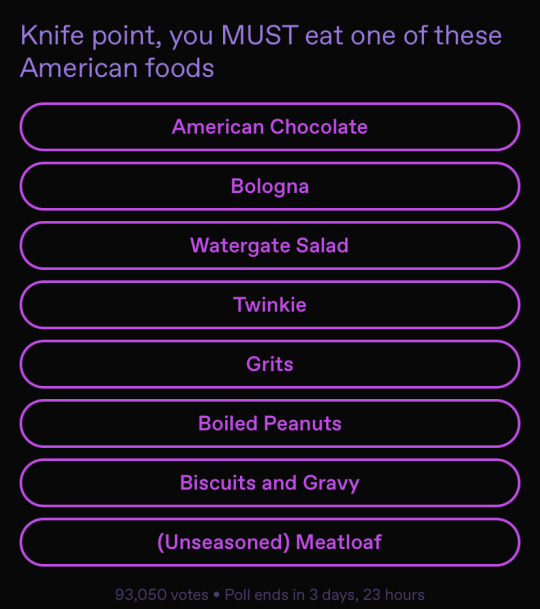
American Chocolate tastes different because of two factors: the majority of our cacao comes from South America unlike Europe which generally imports from Africa (moving product farther costs more money). Also, American chocolate is only required to have 10% cacao as opposed to Europe’s 20% (using less cacao and supplementing with readily available sweeteners like corn syrup costs less money). In fact, the very first American Chocolate company (Baker Chocolate Company) was so aware of how much less wealthy the early US was than Europe’s established market for chocolate, that their bars came with a money back guarantee for anyone who was disappointed with the sweets. The current financial situation in the US is well known to the rest of the world- of course we still make and eat cheap chocolate, the bones of our country are exploitation. Also, the dairy content is lower in American chocolates which makes them more shelf stable. Shelf stable foods are important for communities living paycheck to paycheck who have money for a chocolate bar right now but won’t for their kid’s birthday in a week.
Bologna feels self explanatory to me. It’s made of literal scraps from the meat production industry that are then turned into a “sausage” and cured to give the product more longevity. I like fried bologna because it was cheaper for my dad’s parents when he was a kid. My dad likes bologna for the same reason.
Watergate Salad is made of shelf stable ingredients. Many desserts require eggs or dairy that can be expensive and expire quickly. Those desserts then get stale if they aren’t eaten immediately. Canned fruits, pistachio pudding mix, and cool whip (which is hydrogenated oil and very little dairy) will all keep for a while. You can buy them in bulk and put them in your cabinets or freezer until you want to use them and then the salad itself will keep in the fridge. See again the importance of shelf stable foods to impoverished communities.
Twinkies are cheap and go stale slowly. See again the importance of shelf stable foods in impoverished communities.
Grits, Boiled Peanuts, and Biscuits and Gravy are all southern comfort food staples. I was born and raised in north Georgia, it’s very important to me to note that almost all southern food was co-opted from freed slaves by poor rural white folk in the south. Plain grits can be deeply unappetizing but they are cheap and self stable. You can add butter and salt or even seasoned meat and veggies. Grits are rarely a whole meal all to themselves and when they are you add some cheese or salt at the very least. George Washington Carver (a black man many people outside of Georgia should acquaint themselves with at least a little better) turned peanuts into a massive cash crop in Georgia because they are nitrogen fixing! They replace the nitrogen other cash crops (like cotton and tobacco) take out of the soil. In order for your fields to stay viable, you have to plant something like this every once in a while, so most farmers had peanuts themselves or had a neighbor growing peanuts. Boiling them is a quick, easy way to get salt on the nuts themselves. The water soaks through the shells and seasons and softens the nuts. Water is free and peanuts will keep until the fats start to go south, no wonder they picked up popularity among rural folk and travelers alike. Biscuits and gravy are another scrap food. A good sausage gravy is made of leftover sausage and southern biscuits are a savory, buttery carb that is filling and gives you energy you need somewhere like a farm. The negative stereotypes of the south are pervasive and often rooted in racism. Find someone whose grandma has been making these foods her whole life before you form an opinion.
Meatloaf is seasoned more often than not. Like. Sorry you ate meatloaf that wasn’t salted. Anyway, meatloaf is another scrap food! Meat scraps are ground up and then formed into a loaf. Most people put tomato sauce or ketchup on it. Canned tomato products are, you guessed it, shelf stable, and can also be canned at home fairly safely.
The United States at large is not ignorant of the world around it. We are aware that other foods exist. Either we are choosing to eat these or our financial situations are backing us into corners. This is all without even touching upon the prevalence of food deserts in low-income, minority communities in the US. If you’re aware of all this and you really just want to critique the wealth disparity in the US, punch up. Go after the guys with money, not the food that the rest of us find joy in making out of the scraps. Also, making fun of the British is always punching up. Maybe if you had caused fewer wealth disparities that directly impacted the food eaten in other countries, we would be nicer about yours.
#I wrote all this on mobile#so i couldn't link sources#but google is free#american food#american food poll#biscuits and gravy#american chocolate#bologna#watergate salad#twinkies#grits#boiled peanuts#meatloaf#long post
175 notes
·
View notes
Text


Biotechnology and the future of humanity
The End Of Diversity
GM technology is also set to plunge countless thousands of people into poverty by using GM plants or tissue cultures to produce certain products which have up until now only been available from agricultural sources in the majority world. For example, lauric acid is widely used in soap and cosmetics and has always been derived from coconuts. Now oilseed rape has been genetically modified to produce it and Proctor & Gamble, one of the largest buyers of lauric acid, have opted for the GM source. This is bound to have a negative effect on the 21 million people employed in the coconut trade in the Philippines and the 10 million people in Kerala, India, who are dependent on coconuts for their livelihood. Millions of smallscale cocoa farmers in West Africa are now under threat from the development of GM cocoa butter substitutes. In Madagascar some 70,000 vanilla farmers face ruin because vanilla can now be produced from GM tissue cultures. Great isn’t it? 70,000 farming families will be bankrupted and thrown off the land and instead we’ll have half a dozen factories full of some horrible biotech gloop employing a couple of hundred people. And what will happen to those 70,000 families? Well, the corporations could buy up the land and employ 10% of them growing GM cotton or tobacco or some such crap and the rest can go rot in some shantytown. This is what the corporations call ‘feeding the world’.
Poisoning the earth and its inhabitants brings in big money for the multinationals, large landowners and the whole of the industrial food production system. Traditional forms of organic, small-scale farming using a wide variety of local crops and wild plants (so-called’ weeds’) have been relatively successful at supporting many communities in relative self-sufficiency for centuries. In total contrast to industrial capitalisms chemical soaked monocultures, Mexico’s Huastec indians have highly developed forms of forest management in which they cultivate over 300 different plants in a mixture of gardens,’ fields’ and forest plots. The industrial food production system is destroying the huge variety of crops that have been bred by generations of peasant farmers to suit local conditions and needs. A few decades ago Indian farmers were growing some 50,000 different varieties of rice. Today the majority grow just a few dozen. In Indonesia 1,500 varieties have been lost in the last 15 years. Although a plot growing rice using modern so-called ‘High Yielding Varieties’ with massive inputs of artificial fertilisers and biocides produces more rice for the market than a plot being cultivated by traditional organic methods, the latter will be of more use to a family since many other species of plant and animal can be collected from it. In West Bengal up to 124 ‘weed’ species can be collected from traditional rice fields that are of use to farmers. The sort of knowledge contained in these traditional forms of land use will be of great use to us in creating a sustainable future on this planet; it is the sort of knowledge the corporations are destroying to trap us all in their nightmare world of wage labour, state and market.
#biotech#classism#ecology#climate crisis#anarchism#resistance#community building#practical anarchy#practical anarchism#anarchist society#practical#revolution#daily posts#communism#anti capitalist#anti capitalism#late stage capitalism#organization#grassroots#grass roots#anarchists#libraries#leftism#social issues#economy#economics#climate change#climate#anarchy works#environmentalism
8 notes
·
View notes
Link
0 notes
Text
The commodification of gender identity under capitalism turns personal struggles into profit opportunities for industries that offer gender affirming surgeries and treatments. Feminists argue that this commodification detracts from the deeper social issues that underlie gender identity, turning it into a marketable product rather than a genuine expression of self. Capitalism's exploitation of women's bodies is evident in the beauty industry, where products are marketed as empowering while reinforcing harmful beauty standards. Feminists argue that the industry profits from women's insecurities, keeping them trapped in a cycle of consumption that benefits corporations while undermining their confidence and autonomy. I've developed so much fatigue over online radfem spaces to be honest, like yeah I still align with the politics and I don't think that'll ever really change, but I'm at a point where I can't get over the inaction of online political spaces…not saying that there's none of this happening but, we have to organize, we have to venture into the material world. There's risks that have to be discussed and addressed sure but there's more risk to staying silent & also strength in numbers. Being crypto is reasonable, but how can we move forward? These are things that need to seriously be considered for any sort of real societal shift or activism to happen, or even for us to just have irl connections which are so, so invaluable and so different from digital ones. Radical feminists critique sex work as an exploitative industry that thrives on women’s vulnerabilities. While they support protecting sex workers from harm, they also argue for dismantling the conditions that force women into these roles. By addressing systemic issues like poverty, abuse, and lack of opportunity, feminists aim to create a society where women don’t have to rely on selling their bodies for survival. If having a moid to snuggle at night is worth the death of little girls to you then you’re not a radfem, you’re not a libfem, you’re not a woman, you’re not a human, you are a roach and I’m an exterminator and it’s on sight. “Not antifeminist†my foot, my bloody, bloody foot that’s cracking open your skull

this picture says it all. If I had a funny animal for every time vagina tried to exprickilor, Id own peanut butter jar.
#terfsafe#ecofeminism#kill all moids#female separatism#gender ideology#anti sex industry#gender critical#peaktrans#gender criticism
6 notes
·
View notes